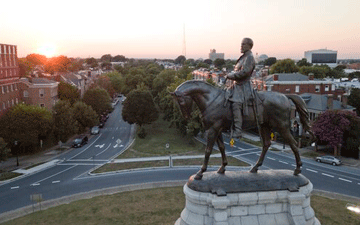
(AP Photo/Steve Helber)
Kirk O. Hanson is a senior fellow at the Markkula Center for Applied Ethics. Views are his own.
All human cultures use symbols to represent their core values and collective identity. We treasure most of these symbols, including the American flag which represents our collective effort to build a nation of equality and freedom through robust democracy, and we honor the varied religious symbols emblazoned on our churches, synagogues and temples. Many of our social service agencies, and even a for-profit company, use interlocking or welcoming hands to symbolize a commitment to cooperation and providing assistance when it is needed. You are in good hands!
But symbols can also be threatening. We immediately recognize Ku Klux Klan costumes, burning crosses, and the Nazi swastikas as symbols used to intimidate and assert the superiority of one race over others. Symbols can destroy the chance for constructive relationships, or can stimulate a new resolve to build community and address our common problems.
Symbols are a particularly powerful form of communication. They quickly convey inclusion and exclusion, compassion or disrespect, even bullying. I have become increasingly alarmed by the impact of symbols on the level of incivility in our society. Incivility leads to extreme partisanship and to gridlock as we retreat into different tribes who have contempt for one another.
We must have a certain level of respect, even for those who disagree with us, to sustain democracy. If our most common and cherished symbols insult each other, it can make it impossible to compromise and address the most important matters facing our communities and our nation.
I am most concerned today over the deliberate use of symbols to communicate disrespect and to belittle others in our national debate. The President’s use of the chant “Lock her up” and dismissive symbolic language mentioning “losers” and “enemies of the people” are clearly designed to intimidate and bully, and hinder the workings of the democratic process. Some others would argue that the cries of an “illegitimate presidency” demonstrate that the use of negative symbols is bipartisan.
Defining when a symbol is disrespectful to others and their cherished values is sometimes hard. The debate over kneeling during the national anthem illustrates how symbols can be used and interpreted differently. Both the national anthem and the kneeling are powerful symbols. The NFL players who knelt believed their symbolic action was still honoring the nation and the national anthem but called Americans to be concerned about the unequal application of the law. Their critics believed kneeling was itself disrespectful whatever the motive.
Society’s understanding of symbols can change over time. Black-face costumes and “poverty theme parties,” common in an earlier time when whites and the majority middle class defined the dominant culture, are clearly understood today as objectionable, indeed that they were always objectionable. How culpable, though, should one be for participating in, or tolerating, these symbols years ago. Are all who played “Cowboys and Indians” in their youth guilty of gross insensitivity? Is it enough to declare today that one knows this symbolic play was wrong. How culpable is Stanford that its sports teams for years were once known as the Indians, or the Atlanta Braves’ whose mascot was previously called “Chief Knockahoma?”
Only a clear-eyed understanding of what symbols mean today and meant at the time they were created will help us today. The continuing struggle over Confederate war monuments, for example, ignores that many of these monuments were erected in the 1890 to 1910 period as part of a resurgence of white supremacy. Even without that history, it is appropriate to take into account the offense given to particular groups by the continued use of a now questionable symbol. Nonetheless, sensitivity has its limits and distant history can legitimately be remembered as history without calling it out as a symbol for today.
I look to the cities and the 50 states to lead the nation to a more appropriate use of symbols and to the chance for greater civility. We need new symbols which allow cities, states, and eventually the national government, to celebrate our collective identity and not our exclusive tribal identities. Maybe we need an event or ceremony which symbolizes the bipartisan commitment to cooperative problem solving, perhaps a national service day dedicated to serving others, even a local parade designed to unite rather than divide the community.
Only a heightened appreciation for the power of symbols and for the damage or good they can do will lead us in the right direction. Only a more thoughtful use of symbols will lead us to greater civility, and thus to a more resilient and effective democracy.
